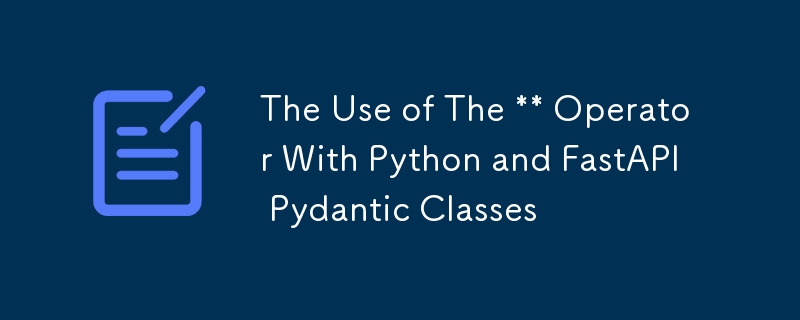Python 和 FastAPI Pydantic 类中 ** 运算符的使用

Python 中的 ** 运算符是上下文相关的或取决于它的使用对象;当与数字一起使用时(通常在两个数字之间),它用作 求幂运算符 。然而,在本文中,我们将研究使用它的另一个上下文。我们将研究它作为解包运算符的用途,用于解包Python字典。
任何用 Python 编写过代码的人都一定见过 **kwargs。关键字参数的缩写。它们是以 key = value 语法传递给函数的参数。当我们不知道将传递到函数中的关键字参数的数量时,使用 kwargs。 **kwargs 是一种字典类型,与将字典传递给函数一样好。该词典包含:
- 参数名称对应的键。
- 与参数值对应的值。
按照这个逻辑,在本文中,我们将研究它在 Python 中的用例,并构建它在具有 Pydantic 类的 FastAPI 中的用例。
将关注以下几点。
- 与 Python 函数一起使用。
- 与 Python 类一起使用。
- 与 FastAPI Pydantic 类一起使用。
- 使用的好处。
注意:不强制使用 kwargs,您可以使用任何其他命名约定,例如**myArgs,**任何东西等等
先决条件
- Python 类和函数的知识。
- FastAPI的一些基础知识。
与 Python 函数一起使用
在这个例子中,我们将有许多关键字参数作为 **kwargs 传递给函数,并且由于 **kwargs 是一个字典,我们将在其上使用字典方法 .items() 。 .items() 方法返回一个视图对象,该对象显示字典的键值元组对的列表。
def print_details(**kwargs):
# kwargs is a dictionary containing all keyword arguments
print(type(kwargs)) # Output:
print(kwargs.items()) # Displays the dictionary items (key-value pairs)
# Iterate over the key-value pairs in kwargs
for key, value in kwargs.items():
print(f"{key}: {value}")
# Calling the function with multiple keyword arguments
print_details(name="Stephen", age=30, profession="Software Developer")
输出
dict_items([('name', 'Stephen'), ('age', 30), ('profession', 'Software Developer')]) name: Stephen age: 30 profession: Software Developer
与 Python 类一起使用
我们一定已经注意到,Python 类是可调用的;这意味着我们可以像调用函数一样调用类。调用一个类会创建该类的一个实例(对象)。
class Tech:
def __init__(self, dev, devops, design):
self.dev = dev
self.devops = devops
self.design = design
# Call class to create an instance
tech = Tech(dev, devops, design)
使用参数值调用 Tech 将返回实例 tech。
在类中, ** 运算符解包字典,允许每个键值对作为命名参数传递给类构造函数。
在本节的示例中,我们定义了一个类。我们定义一个字典,其属性与类参数匹配。然后我们创建该类的一个实例,使用 ** 来解压字典。
class Tech:
def __init__(self, dev, devops, design):
self.dev = dev
self.devops = devops
self.design = design
# Define a dictionary with properties matching the class's parameters
tech_team = {
'dev': 'Stephen',
'devops': ['Jenny', 'Rakeem', 'Stanley'],
'design': 'Carlos'
}
# Create an instance of the class using ** to unpack the dictionary
tech = Tech(**tech_team)
print(tech.dev)
print(tech.devops)
print(tech.design)
上面的代码相当于:
class Tech:
def __init__(self, dev, devops, design):
self.dev = dev
self.devops = devops
self.design = design
# Define a dictionary with properties matching the class's parameters
tech_team = {
'dev': 'Stephen',
'devops': ['Jenny', 'Rakeem', 'Stanley'],
'design': 'Carlos'
}
# Create an instance of the class
tech = Tech(
dev = tech_team["dev"],
devops = tech_team["devops"],
design = tech_team["design"]
)
print(tech.dev)
print(tech.devops)
print(tech.design)
这是因为:
tech = Tech(**Tech_team)
等同于:
tech = Tech(
dev = tech_team["dev"],
devops = tech_team["devops"],
design = tech_team["design"]
)
与 FastAPI Pydantic 类一起使用
Pydantic是一个用于数据验证的Python库,通过使用Python3的类型提示系统,它甚至被誉为Python中使用最广泛的数据验证库。 FastAPI 中使用的 Pydantic 帮助我们定义数据模型,简单来说就是类。
在我们的类中,我们可以为属性或字段指定类型,例如 str、int、float、List。提供数据后,Pydantic 会进行检查以确保其匹配。
除此之外,Pydantic 还有助于解析和序列化。序列化是将数据对象传输为易于传输的格式的过程;例如,将对象或数组转换为 JSON 格式,以使其简单且易于解析。
Pydantic 有一个 BaseModel 类,定义的类继承自该类。以下是 Pydantic 模型的示例:
from pydantic import BaseModel, EmailStr
# We import the BaseModel and Emailstr type from Pydantic
class UserInDB(BaseModel):
username: str
hashed_password: str
email: EmailStr
full_name: Union[str, None] = None
假设我们有:
class Item(BaseModel):
name:str
price:float
app = FastAPI()
@app.post("/items/")
async def create_item(item:Item):
return item
在上面的代码中,item是请求体参数,是Item模型的一个实例。它用于验证和序列化传入的 JSON 请求正文,以确保其与 Item 模型中定义的结构匹配。
Pydantic 的 .dict() 方法
Pydantic 模型有一个 .dict() 方法,它返回包含模型数据的字典。
如果我们创建一个 pydantic 模型实例:
item = Item(name="sample item", price=5.99)
然后我们用它调用 dict():
itemDict = item.dict() print(itemDict)
我们现在有一个字典,我们的输出将是:
{
"name": "sample item",
"price":5.99
}
注意:
Item(name="sample item", price=5.99)
相当于
# Using the unpacking operator Item(**itemDict) # Or Item( name=itemDict["name"], price=itemDict["price" )
使用的好处
我们现在将看看使用拆包运算符是有益的一些情况。
- 通过添加或修改条目从预先存在的词典创建新词典。
original_dict = {"name": "Stephen", "age": 30, "profession": "Software Developer"}
# Creating a new dictionary with additional or modified entries
new_dict = {**original_dict, "age": 31, "location": "New York"}
print(new_dict)
- 将字典合二为一。使用解包运算符,我们可以合并多个字典。
default_config = {"theme": "light", "notifications": True}
user_config = {"theme": "dark"}
# Merging dictionaries using unpacking
final_config = {**default_config, **user_config}
print(final_config)
- 以动态方式处理函数中的参数。这可以在我们早期的示例中看到。
结论
字典解包运算符 ** 是值得考虑使用的一个,因为它具有处理函数和类中的参数以及合并和创建新字典的动态特性。所有这些放在一起可以减少代码并更好地维护代码。
-
 如何使用Regex在PHP中有效地提取括号内的文本php:在括号内提取文本在处理括号内的文本时,找到最有效的解决方案是必不可少的。一种方法是利用PHP的字符串操作函数,如下所示: 作为替代 $ text ='忽略除此之外的一切(text)'; preg_match('#((。 &&& [Regex使用模式来搜索特...编程 发布于2025-04-05
如何使用Regex在PHP中有效地提取括号内的文本php:在括号内提取文本在处理括号内的文本时,找到最有效的解决方案是必不可少的。一种方法是利用PHP的字符串操作函数,如下所示: 作为替代 $ text ='忽略除此之外的一切(text)'; preg_match('#((。 &&& [Regex使用模式来搜索特...编程 发布于2025-04-05 -
 您可以使用CSS在Chrome和Firefox中染色控制台输出吗?在javascript console 中显示颜色是可以使用chrome的控制台显示彩色文本,例如红色的redors,for for for for错误消息?回答是的,可以使用CSS将颜色添加到Chrome和Firefox中的控制台显示的消息(版本31或更高版本)中。要实现这一目标,请使用以下模...编程 发布于2025-04-05
您可以使用CSS在Chrome和Firefox中染色控制台输出吗?在javascript console 中显示颜色是可以使用chrome的控制台显示彩色文本,例如红色的redors,for for for for错误消息?回答是的,可以使用CSS将颜色添加到Chrome和Firefox中的控制台显示的消息(版本31或更高版本)中。要实现这一目标,请使用以下模...编程 发布于2025-04-05 -
 我可以将加密从McRypt迁移到OpenSSL,并使用OpenSSL迁移MCRYPT加密数据?将我的加密库从mcrypt升级到openssl 问题:是否可以将我的加密库从McRypt升级到OpenSSL?如果是这样,如何?答案:是的,可以将您的Encryption库从McRypt升级到OpenSSL。可以使用openssl。附加说明: [openssl_decrypt()函数要求iv参...编程 发布于2025-04-05
我可以将加密从McRypt迁移到OpenSSL,并使用OpenSSL迁移MCRYPT加密数据?将我的加密库从mcrypt升级到openssl 问题:是否可以将我的加密库从McRypt升级到OpenSSL?如果是这样,如何?答案:是的,可以将您的Encryption库从McRypt升级到OpenSSL。可以使用openssl。附加说明: [openssl_decrypt()函数要求iv参...编程 发布于2025-04-05 -
 为什么我的CSS背景图像出现?故障排除:CSS背景图像未出现 ,您的背景图像尽管遵循教程说明,但您的背景图像仍未加载。图像和样式表位于相同的目录中,但背景仍然是空白的白色帆布。而不是不弃用的,您已经使用了CSS样式: bockent {背景:封闭图像文件名:背景图:url(nickcage.jpg); 如果您的html,css...编程 发布于2025-04-05
为什么我的CSS背景图像出现?故障排除:CSS背景图像未出现 ,您的背景图像尽管遵循教程说明,但您的背景图像仍未加载。图像和样式表位于相同的目录中,但背景仍然是空白的白色帆布。而不是不弃用的,您已经使用了CSS样式: bockent {背景:封闭图像文件名:背景图:url(nickcage.jpg); 如果您的html,css...编程 发布于2025-04-05 -
 eval()vs. ast.literal_eval():对于用户输入,哪个Python函数更安全?称量()和ast.literal_eval()中的Python Security 在使用用户输入时,必须优先确保安全性。强大的python功能eval()通常是作为潜在解决方案而出现的,但担心其潜在风险。 This article delves into the differences betwee...编程 发布于2025-04-05
eval()vs. ast.literal_eval():对于用户输入,哪个Python函数更安全?称量()和ast.literal_eval()中的Python Security 在使用用户输入时,必须优先确保安全性。强大的python功能eval()通常是作为潜在解决方案而出现的,但担心其潜在风险。 This article delves into the differences betwee...编程 发布于2025-04-05 -
 如何在Java字符串中有效替换多个子字符串?在java 中有效地替换多个substring,需要在需要替换一个字符串中的多个substring的情况下,很容易求助于重复应用字符串的刺激力量。 However, this can be inefficient for large strings or when working with nu...编程 发布于2025-04-05
如何在Java字符串中有效替换多个子字符串?在java 中有效地替换多个substring,需要在需要替换一个字符串中的多个substring的情况下,很容易求助于重复应用字符串的刺激力量。 However, this can be inefficient for large strings or when working with nu...编程 发布于2025-04-05 -
 在程序退出之前,我需要在C ++中明确删除堆的堆分配吗?在C中的显式删除 在C中的动态内存分配时,开发人员通常会想知道是否有必要在heap-procal extrable exit exit上进行手动调用“ delete”操作员,但开发人员通常会想知道是否需要手动调用“ delete”操作员。本文深入研究了这个主题。 在C主函数中,使用了动态分配变量(H...编程 发布于2025-04-05
在程序退出之前,我需要在C ++中明确删除堆的堆分配吗?在C中的显式删除 在C中的动态内存分配时,开发人员通常会想知道是否有必要在heap-procal extrable exit exit上进行手动调用“ delete”操作员,但开发人员通常会想知道是否需要手动调用“ delete”操作员。本文深入研究了这个主题。 在C主函数中,使用了动态分配变量(H...编程 发布于2025-04-05 -
 如何干净地删除匿名JavaScript事件处理程序?删除匿名事件侦听器将匿名事件侦听器添加到元素中会提供灵活性和简单性,但是当要删除它们时,可以构成挑战,而无需替换元素本身就可以替换一个问题。 element? element.addeventlistener(event,function(){/在这里工作/},false); 要解决此问题,请考虑...编程 发布于2025-04-05
如何干净地删除匿名JavaScript事件处理程序?删除匿名事件侦听器将匿名事件侦听器添加到元素中会提供灵活性和简单性,但是当要删除它们时,可以构成挑战,而无需替换元素本身就可以替换一个问题。 element? element.addeventlistener(event,function(){/在这里工作/},false); 要解决此问题,请考虑...编程 发布于2025-04-05 -
 如何使用PHP从XML文件中有效地检索属性值?从php $xml = simplexml_load_file($file); foreach ($xml->Var[0]->attributes() as $attributeName => $attributeValue) { echo $attributeName,...编程 发布于2025-04-05
如何使用PHP从XML文件中有效地检索属性值?从php $xml = simplexml_load_file($file); foreach ($xml->Var[0]->attributes() as $attributeName => $attributeValue) { echo $attributeName,...编程 发布于2025-04-05 -
 对象拟合:IE和Edge中的封面失败,如何修复?To resolve this issue, we employ a clever CSS solution that solves the problem:position: absolute;top: 50%;left: 50%;transform: translate(-50%, -50%)...编程 发布于2025-04-05
对象拟合:IE和Edge中的封面失败,如何修复?To resolve this issue, we employ a clever CSS solution that solves the problem:position: absolute;top: 50%;left: 50%;transform: translate(-50%, -50%)...编程 发布于2025-04-05 -
 如何使用Java.net.urlConnection和Multipart/form-data编码使用其他参数上传文件?使用http request 上传文件上传到http server,同时也提交其他参数,java.net.net.urlconnection and Multipart/form-data Encoding是普遍的。 Here's a breakdown of the process:Mu...编程 发布于2025-04-05
如何使用Java.net.urlConnection和Multipart/form-data编码使用其他参数上传文件?使用http request 上传文件上传到http server,同时也提交其他参数,java.net.net.urlconnection and Multipart/form-data Encoding是普遍的。 Here's a breakdown of the process:Mu...编程 发布于2025-04-05 -
 如何使用Python的请求和假用户代理绕过网站块?如何使用Python的请求模拟浏览器行为,以及伪造的用户代理提供了一个用户 - 代理标头一个有效方法是提供有效的用户式header,以提供有效的用户 - 设置,该标题可以通过browser和Acterner Systems the equestersystermery和操作系统。通过模仿像Chro...编程 发布于2025-04-05
如何使用Python的请求和假用户代理绕过网站块?如何使用Python的请求模拟浏览器行为,以及伪造的用户代理提供了一个用户 - 代理标头一个有效方法是提供有效的用户式header,以提供有效的用户 - 设置,该标题可以通过browser和Acterner Systems the equestersystermery和操作系统。通过模仿像Chro...编程 发布于2025-04-05 -
 版本5.6.5之前,使用current_timestamp与时间戳列的current_timestamp与时间戳列有什么限制?在时间戳列上使用current_timestamp或MySQL版本中的current_timestamp或在5.6.5 此限制源于遗留实现的关注,这些限制需要对当前的_timestamp功能进行特定的实现。 创建表`foo`( `Productid` int(10)unsigned not n...编程 发布于2025-04-05
版本5.6.5之前,使用current_timestamp与时间戳列的current_timestamp与时间戳列有什么限制?在时间戳列上使用current_timestamp或MySQL版本中的current_timestamp或在5.6.5 此限制源于遗留实现的关注,这些限制需要对当前的_timestamp功能进行特定的实现。 创建表`foo`( `Productid` int(10)unsigned not n...编程 发布于2025-04-05 -
 如何将MySQL数据库添加到Visual Studio 2012中的数据源对话框中?在Visual Studio 2012 尽管已安装了MySQL Connector v.6.5.4,但无法将MySQL数据库添加到实体框架的“ DataSource对话框”中。为了解决这一问题,至关重要的是要了解MySQL连接器v.6.5.5及以后的6.6.x版本将提供MySQL的官方Visual...编程 发布于2025-04-05
如何将MySQL数据库添加到Visual Studio 2012中的数据源对话框中?在Visual Studio 2012 尽管已安装了MySQL Connector v.6.5.4,但无法将MySQL数据库添加到实体框架的“ DataSource对话框”中。为了解决这一问题,至关重要的是要了解MySQL连接器v.6.5.5及以后的6.6.x版本将提供MySQL的官方Visual...编程 发布于2025-04-05
学习中文
- 1 走路用中文怎么说?走路中文发音,走路中文学习
- 2 坐飞机用中文怎么说?坐飞机中文发音,坐飞机中文学习
- 3 坐火车用中文怎么说?坐火车中文发音,坐火车中文学习
- 4 坐车用中文怎么说?坐车中文发音,坐车中文学习
- 5 开车用中文怎么说?开车中文发音,开车中文学习
- 6 游泳用中文怎么说?游泳中文发音,游泳中文学习
- 7 骑自行车用中文怎么说?骑自行车中文发音,骑自行车中文学习
- 8 你好用中文怎么说?你好中文发音,你好中文学习
- 9 谢谢用中文怎么说?谢谢中文发音,谢谢中文学习
- 10 How to say goodbye in Chinese? 再见Chinese pronunciation, 再见Chinese learning

























